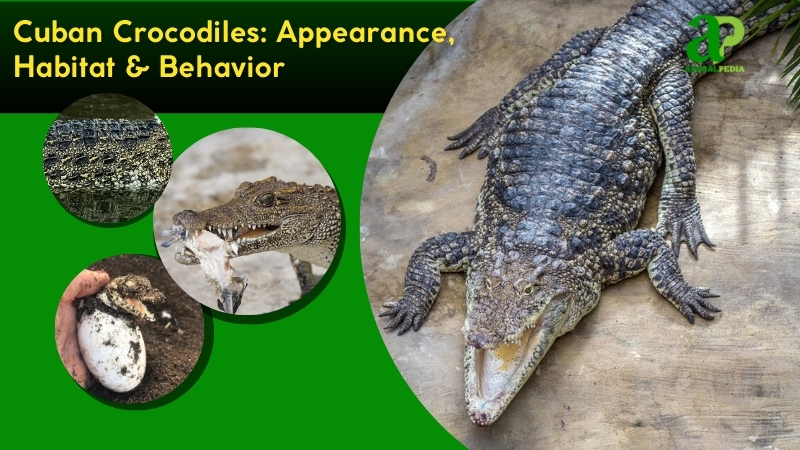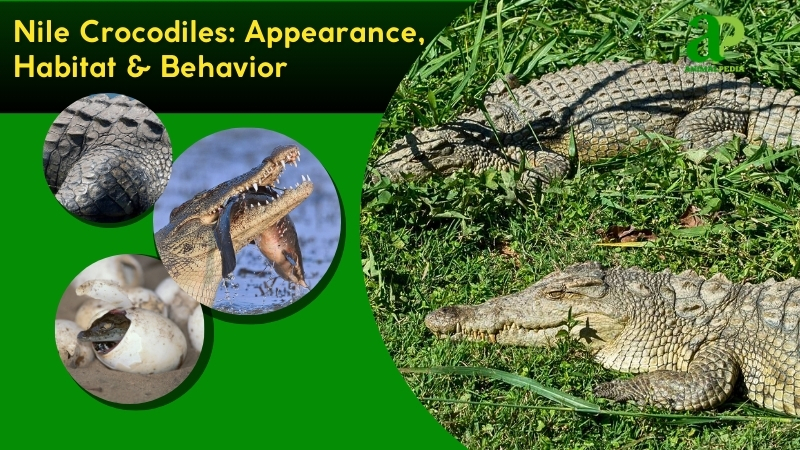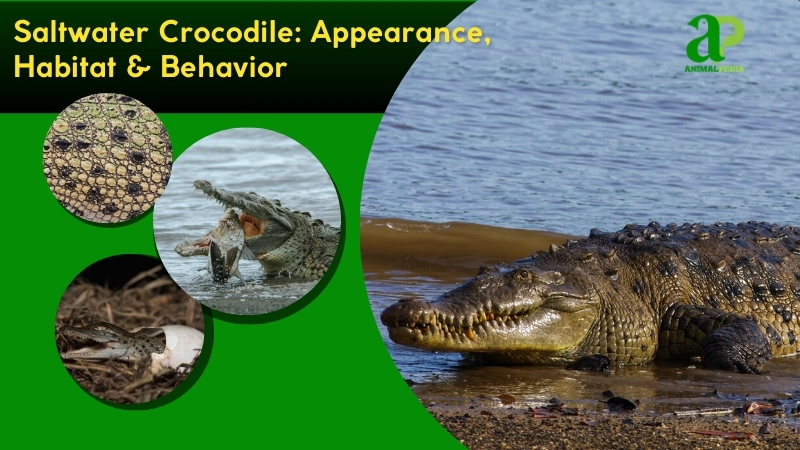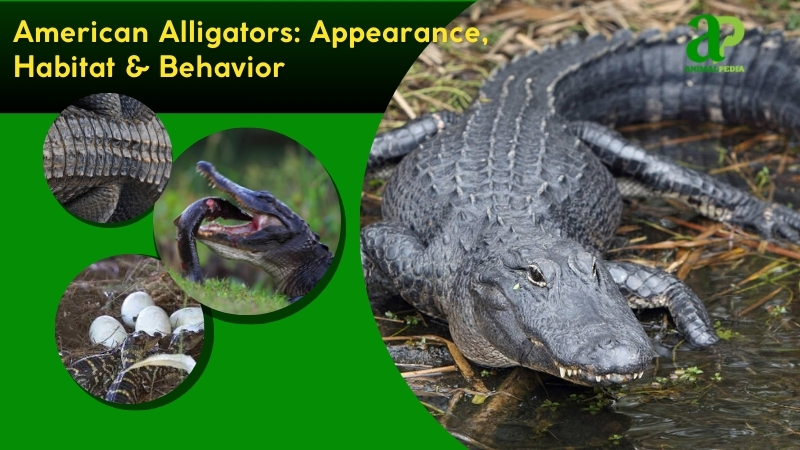The marsh crocodile, a formidable reptile, captivates with its rugged appearance and primal presence. Approximately 17 species of crocodiles exist worldwide, but the marsh crocodile stands out in its genus. This article explores its defining traits—from physical features to predatory prowess—across its unique habitats.
The marsh crocodile, Crocodylus palustris, also known as the mugger crocodile, has a broad snout and armored skin. Its dark, olive-brown scales blend seamlessly with swampy waters. Adults stretch 9.8-13.1 feet (3-4 meters) long, with males occasionally hitting 16.4 feet (5 meters). Native to India, Pakistan, and Sri Lanka, it thrives in freshwater marshes and rivers.
This species dominates wetlands across the Indian subcontinent, with key populations in Gujarat’s Charotar region and Sri Lanka’s Wilpattu National Park. It favors shallow, murky waters—lakes, reservoirs, and slow rivers—where vegetation conceals its bulk. Its size and adaptability distinguish it in these biodiverse ecosystems.
As an apex predator, the marsh crocodile ambushes prey with stealth. It hunts deer, fish, and birds, lunging from water to seize them with powerful jaws. Its diet shifts with availability, showing opportunistic feeding. Human encounters rise near villages, though fatal attacks are rare compared to saltwater cousins.
Mating peaks in winter, with females laying 25-30 eggs in sandy nests by March. Incubation lasts 55-75 days, hatching in the monsoon season. Hatchlings, aggressive from birth, grow fast, reaching maturity in 6-8 years. Lifespan averages 40-50 years, shaped by habitat and threats.
This article dissects the marsh crocodile’s appearance, habitat, and behavior, blending scientific precision with vivid detail. It reveals a top predator sculpted by evolution and ecology.
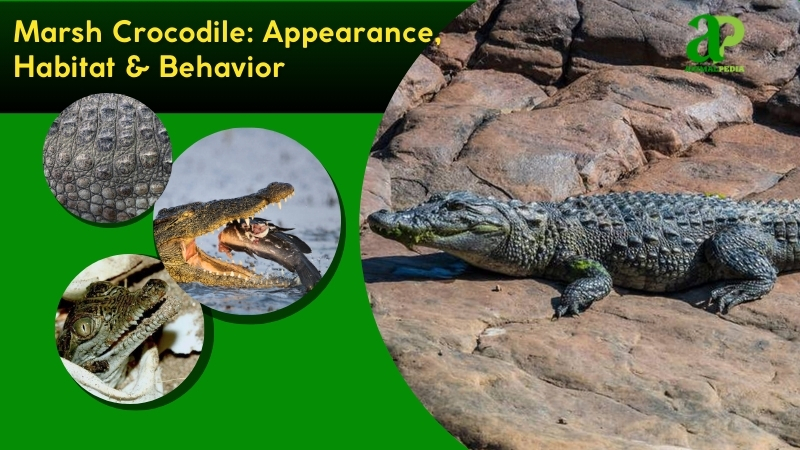
What does the Marsh crocodile look like?
The marsh crocodile, also known as the mugger crocodile, has a long, powerful body built for stealthy water movement. Its color ranges from dark olive-brown to grayish-green, with mottled patterns that help it blend into muddy waters. The skin is tough and covered in bony plates (osteoderms), giving it a rough texture.
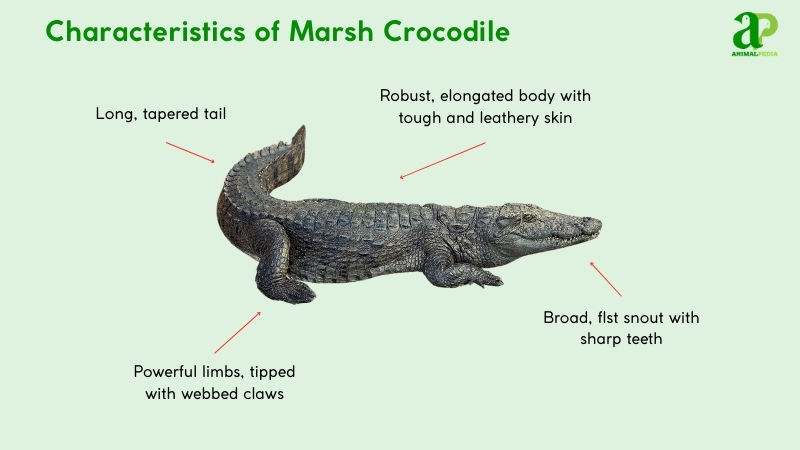
Its broad, flat snout contains sharp teeth, while small, keen eyes sit high for watching while mostly submerged. A thick, powerful neck supports its heavy head, connecting to a cylindrical body. Strong limbs with webbed claws push it through water, and its long, tapering tail—typically 4.9-6.6 feet—powers swimming at speeds up to 15 mph.
The marsh crocodile differs from other species by having a wider snout and a stockier build, compared to the sleeker saltwater crocodile. Its darker skin contrasts with the Nile crocodile’s lighter color. Unlike the gharial’s V-shaped jaws, the mugger’s head is broader and blunter. Its bulkier body excels in ambush hunting, while shorter but sturdier limbs work perfectly in shallow marshes. The tail, thick at the base and sharply tapered, gives this reptile unique agility in its freshwater habitat.
How big do Marsh crocodiles get?
Marsh crocodiles, or mugger crocodiles, average 9.8-13.1 feet (3-4 meters) in length and weigh 440-660 pounds (200-300 kilograms). Males typically outsize females, reaching up to 4 meters, while females hover around 8.2-9.8 feet (2.5-3 meters). Their robust build, honed for ambush, varies across India, Pakistan, and Sri Lanka depending on habitat and food availability.
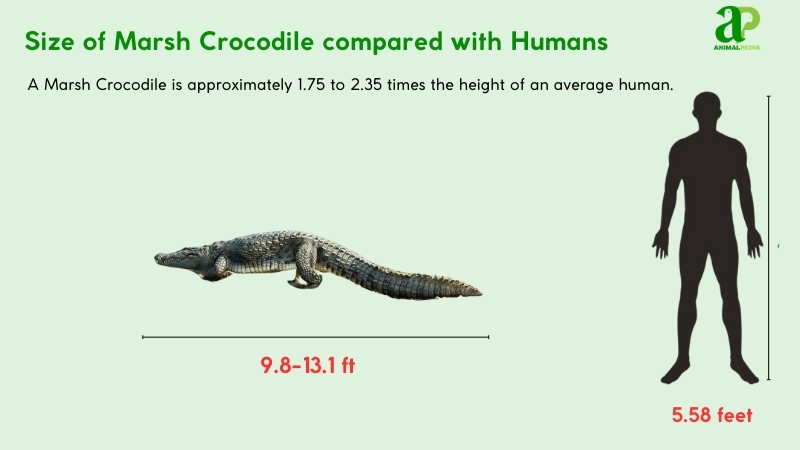
The largest recorded mugger, found in Gujarat, India, stretched 18.5 feet (5.63 meters) and weighed 1,521 pounds (690 kilograms), documented by Whitaker and Whitaker (2015).
Adult males commonly hit 13.1 feet (4 meters) snout-to-tail, females 9.8 feet (3 meters). Males weigh 660-990 pounds (300-450 kilograms), dwarfing females at 330-440 pounds (150-200 kilograms). See the table below for key differences.
| Trait | Male | Female |
| Length | 9.8-13.1 ft (3-4 m) | 8.2-9.8 ft (2.5-3 m) |
| Weight | 660-990 lbs (300-450 kg) | 330-440 lbs (150-200 kg) |
What are the unique physical characteristics of the Species?
The marsh crocodile, or mugger crocodile, possesses distinctive morphological traits that separate it from other crocodile species. Its most notable feature is the exceptionally broad snout—wider than any other crocodile species—combined with a robust, armored body. This snout width contrasts with the narrow jaws of gharials or the pointed muzzles of saltwater crocodiles, enhancing its prey-crushing capacity.
Another unique identifier is the prominent dorsal osteoderms, the bony plates along its back. These structures appear more pronounced and irregular than those of related species, providing superior defense and environmental camouflage in turbid wetlands. Research confirms the snout’s width as a key adaptation for capturing diverse prey in shallow aquatic habitats, from fish to terrestrial mammals.
The collagen-rich osteoderms offer flexibility and strength, distinguishing them from the comparatively smooth osteoderms of the Nile crocodile. Its compact, stocky physique—typically measuring 9.8-13.1 feet (3-4 meters)—perfectly suits its ambush predation strategy in confined marsh ecosystems, unlike the extensive range of larger crocodilian species. These anatomical features establish the marsh crocodile as an adaptive, resilient apex predator in its ecological niche.
How do Marsh crocodiles sense their environment with its unique features?
The marsh crocodile leverages its broad snout, a unique trait, to thrive in the wild. This wide, powerful structure detects waterborne vibrations and pressure changes, pinpointing prey such as fish or deer with precision. It excels in murky marshes, ambushing effortlessly.
Supporting senses amplify this adaptation. Keen eyes, perched high, scan above water for movement, enhancing hunting accuracy. Sensitive ears, sealed underwater, catch low-frequency sounds, alerting it to threats. Bumpy integumentary sense organs along the jaw sense tiny ripples, refining prey detection. A robust olfactory system sniffs chemical cues to track food or mates. Together, these traits make the marsh crocodile a master of its swampy realm.
Anatomy
The marsh crocodile, also known as the mugger crocodile, thrives in South Asia’s wetlands. Its success stems from a highly specialized anatomy, where each physiological system contributes to its role as an apex predator.
- Respiratory System: Nostrils atop the snout and a palatal valve allow submerged breathing. Lungs, large and efficient, support long dives in murky waters.
- Circulatory System: A four-chambered heart pumps blood effectively. It slows metabolism during submersion, conserving oxygen for stealthy hunts.
- Digestive System: Strong jaws crush prey, and a muscular stomach digests bones. Acid breaks down tough foods, enabling it to play its apex role.
- Excretory System: Kidneys filter waste products, which are expelled via the cloaca. Salt glands near the tongue manage salinity in brackish habitats.
- Nervous System: A keen brain processes sensory input. Nerves tied to jaw sensors and eyes sharpen its ambush precision.
These systems, honed by millions of years of evolution, make the marsh crocodile a resilient and formidable predator across rivers, lakes, and marshes in its native range.
Where do Marsh crocodiles live?
Marsh crocodiles inhabit the Indian subcontinent, flourishing across India, Pakistan, Sri Lanka, Nepal, and Bangladesh. They thrive in Gujarat’s Charotar wetlands, Sri Lanka’s Wilpattu National Park, and India’s Ranthambore lakes—freshwater ecosystems teeming with prey.
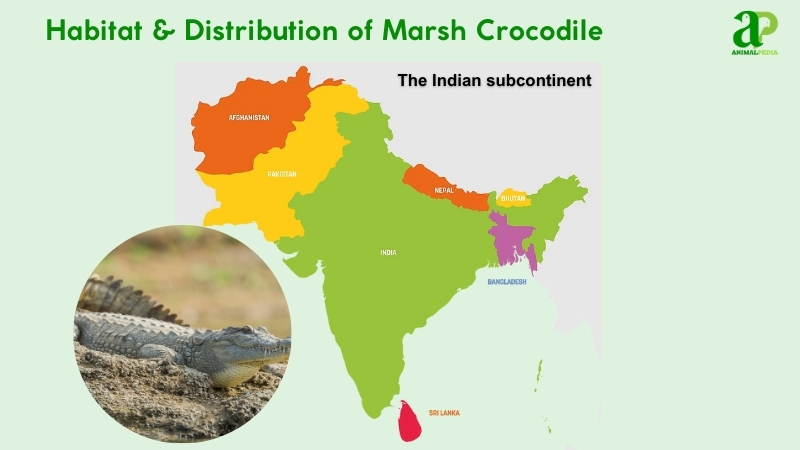
These reptiles prefer shallow, turbid waters—marshes, rivers, and reservoirs—sheltered by thick riparian vegetation. Such habitats complement their ambush predation strategy, their broad snouts camouflaged in muddy substrates. Tropical climates and abundant food sources, such as fish or ungulates, create optimal living conditions.
Paleontological evidence indicates Mugger crocodiles (Crocodylus palustris) have occupied these territories for thousands of years with minimal range shifts. Research by Kumara and Raj (2016) documents their persistence in Gujarat wetlands, attributing their site fidelity to stable aquatic habitats and consistent prey availability. They are sedentary and perfectly adapted to their swampy environments.
How do seasonal changes affect their behavior?
Marsh crocodiles exhibit seasonal behaviors that align with climatic shifts in their habitats. Their life rhythms adapt to optimize energy use, breeding success, and feeding opportunities throughout the year.
- Winter: They bask on banks, conserving energy. Mating peaks, with males bellowing to attract females.
- Summer: Activity drops; they estivate in burrows or deep water to escape heat, hunting less.
- Monsoon: Feeding surges as prey thrives in flooded wetlands. Females lay eggs in sandy nests.
These seasonal adaptations, closely tied to temperature and water cycles, ensure the species’ survival in diverse environments, as documented by Whitaker and Whitaker (2015).
What is the behavior of Marsh crocodiles?
Marsh crocodiles thrive as top predators by combining strength, stealth, and sharp instincts. Their behavior patterns reflect careful adaptations to life in dynamic wetland ecosystems.
- Feeding Habits: They ambush prey such as fish and deer using stealth. Diet shifts with prey availability.
- Bite & Venomous: Their bite crushes with immense force, non-venomous. Jaws lock tight, drowning victims.
- Daily Routines: They bask by day, hunt at dusk. Activity dips in heat.
- Locomotion: They swim with tail thrusts, up to 15 mph (24 km/h). On land, they lumber.
- Social Structures: Mostly solitary, they group during mating. Males defend territories fiercely.
- Communication: Low bellows signal mates or rivals. Body postures assert dominance.
These behaviors ensure marsh crocodiles maintain dominance across fluctuating seasons and shifting wetland habitats.
What do Marsh crocodiles eat?
Marsh crocodiles are carnivorous, eating fish, birds, and mammals such as deer. They favor medium vertebrates in wetlands. They rarely attack humans near villages. They ambush, drag prey underwater, and swallow whole or tear chunks with sharp teeth. For bigger prey, they drown it first, then rip it apart.
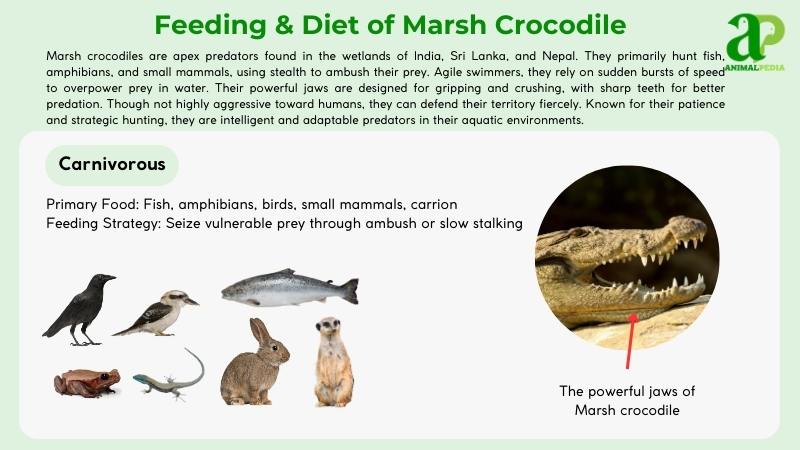
- Diet by Age
Marsh crocodile diets shift with growth. Hatchlings feed on insects, small fish, and amphibians. Juveniles hunt larger fish, frogs, and waterfowl. Adults with increased jaw strength prey on mammals such as deer and domestic livestock. Cannibalism among juveniles has been recorded during food scarcity.
- Diet by Gender
Male and female marsh crocodiles generally share similar diets. However, larger males may monopolize bigger prey, especially during territorial disputes. Nesting females tend to stay close to the water’s edge, preying on smaller, easily captured prey to minimize energy expenditure and protect their nests.
- Diet by Seasons
In the dry season (March to June), marsh crocodiles rely on trapped fish and reduced water prey. During the monsoon (July to October), abundant water and prey boost feeding activity. In winter (November to February), activity slows, but basking allows opportunistic captures of weakened prey.
How do Marsh crocodiles hunt their prey?
Marsh crocodiles are skilled predators, utilizing their exceptional camouflage to blend into their surroundings and wait for unsuspecting prey to approach. When ready, they swiftly strike with their powerful jaws, using their sharp teeth to secure a meal. These predators are agile in the water, able to outmaneuver their victims with ease.
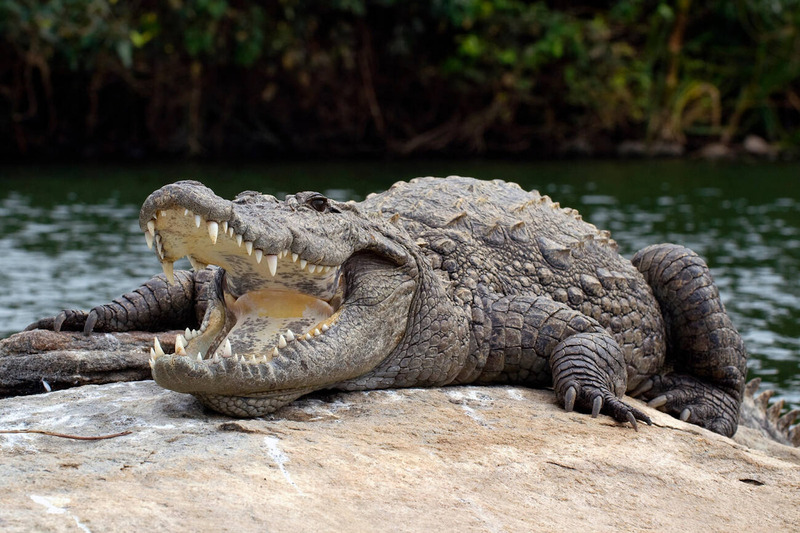
Their typical diet consists of fish, frogs, and small mammals, but they’re known to take on larger prey when the opportunity arises. Marsh crocodiles’ hunting techniques have evolved over millions of years, allowing them to thrive in a variety of wetland habitats.
Their hunting prowess showcases their efficiency and predatory instincts.
Are Marsh crocodiles venomous?
Despite their menacing appearance and predatory behavior, Marsh crocodiles aren’t venomous creatures. These reptiles rely on their powerful jaws and stealthy hunting techniques to catch their prey. Equipped with sharp teeth for tearing flesh and a firm grip, Marsh crocodiles exhibit patience and precision in their hunting strategies. They often lurk near the water’s edge, waiting patiently before swiftly striking their unsuspecting victims.
Known for their calculated approach to hunting, Marsh crocodiles excel at blending into their watery surroundings and selecting the opportune moment to attack. Their ability to motionless for extended periods contributes to their effectiveness as predators in their natural habitat.
Despite their fearsome reputation, these crocodiles serve a significant ecological role in maintaining the balance of wetland ecosystems. Therefore, it’s important to recognize that while Marsh crocodiles are formidable hunters, they pose no threat in terms of venomous capabilities.
When are Marsh crocodiles most active during the day?
Marsh crocodiles are skilled hunters despite lacking venom. These predators are most active at night and in the early morning, preferring to hunt then. As the sun sets, Marsh crocodiles emerge from the water to begin hunting. Their sharp teeth, keen senses, and stealthy movements enable them to stalk their prey with precision under the cover of darkness.
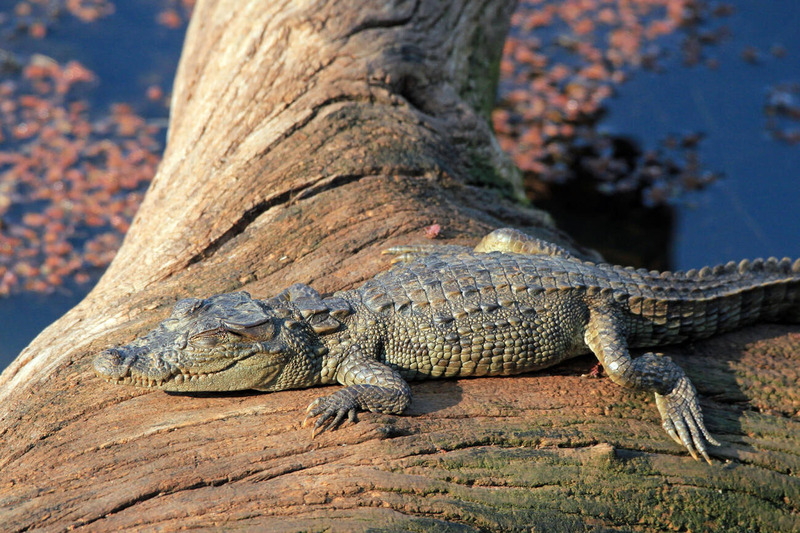
During the day, Marsh crocodiles tend to rest and sunbathe to regulate their body temperature. This behavior helps them conserve energy for their nocturnal hunting excursions.
It’s fascinating to observe how these creatures adapt to their environment, switching between periods of rest and intense hunting, showcasing their impressive survival skills.
How do Marsh crocodiles move on land and water?
Marsh crocodiles move with distinct techniques in both aquatic and terrestrial environments. In water, they propel themselves using their powerful tail as the main locomotive force, reaching speeds up to 15 mph. Their webbed feet serve as rudders for steering and direction changes, while their streamlined body reduces drag.
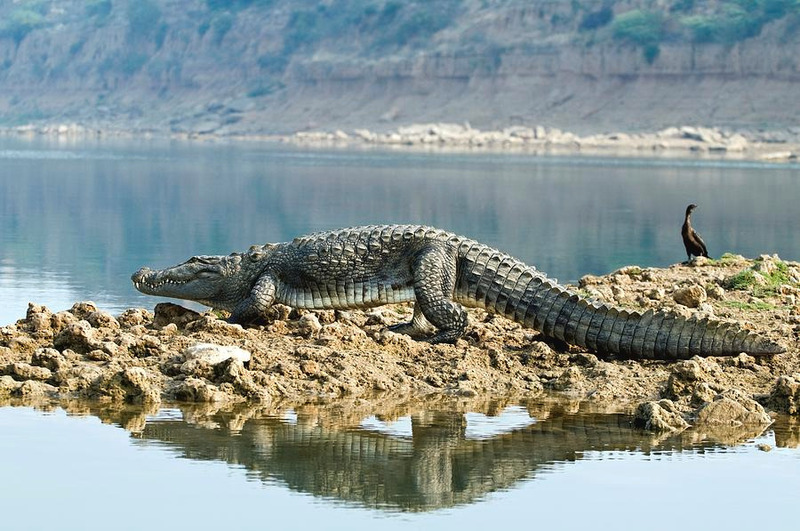
On land, these reptiles display two primary movement patterns. The high-walk involves lifting their body completely off the ground with legs positioned directly beneath them, allowing speeds up to 11 mph for short distances. For longer travel, they use the belly-crawl, dragging their body along the ground while moving their limbs laterally.
Marsh crocodiles, also called mugger crocodiles (Crocodylus palustris), seamlessly transition between these modes of locomotion. Their muscular physiology enables this dual-environment mobility, with a specialized skeletal structure supporting both swimming and walking. This biomechanical adaptation represents a perfect evolutionary balance for their semi-aquatic lifestyle in freshwater habitats across the Indian subcontinent.
Do Marsh crocodiles live alone or in groups?
Marsh crocodiles typically live alone rather than in groups. They’re solitary creatures that enjoy their independence, roaming their territories and hunting for food on their own. These impressive animals can often be seen basking in the sun near water sources, relishing the peace and quiet of their surroundings.
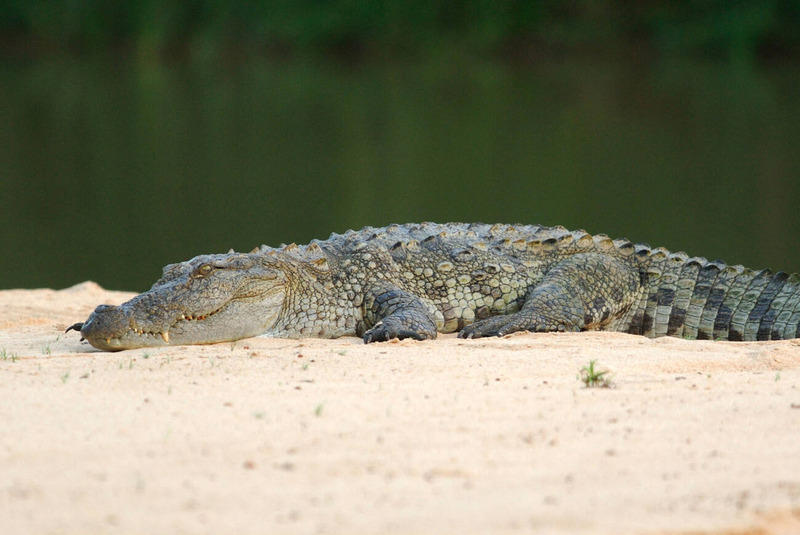
Living solo affords Marsh crocodiles the freedom to make their own choices and navigate their habitats without depending on others. They’re formidable predators, capable of thriving on their own and securing their place in their environments.
While they may occasionally cross paths with other crocodiles, they generally prefer solitude over forming social groups with their own kind.
How do Marsh crocodiles communicate with each other?
Marsh crocodiles communicate through body language and vocalizations to convey messages within their community. They use gestures like head movements, tail swishes, and jaw slaps to express dominance or aggression.
Vocalizations are also crucial, with sounds ranging from hisses to deep bellows that can travel long distances. These bellows help establish territory or attract potential mates, showcasing the intricate communication system of Marsh crocodiles.
Their unique ways of expressing themselves highlight the depth of their social interactions and survival strategies in their environment.
How do Marsh crocodiles reproduce?
Marsh crocodiles reproduce sexually, laying eggs. Breeding season begins in winter, from November to February. Males attract mates by bellowing loudly, creating water vibrations. Females respond with head slaps. They mate in shallow water through a brief, intense ritual.
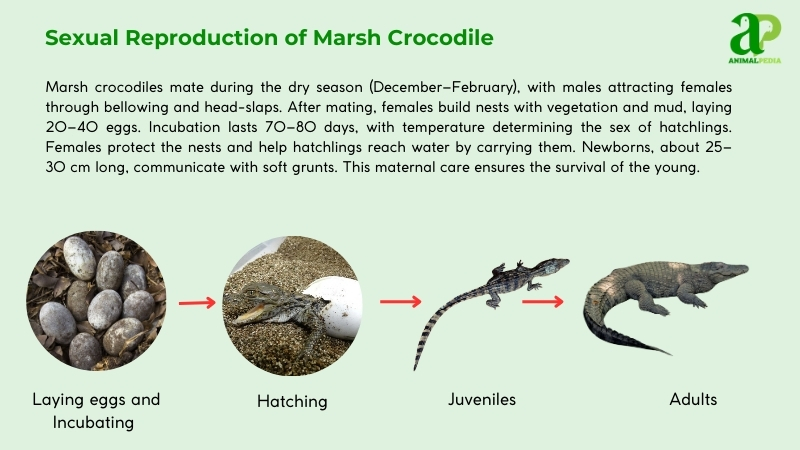
After mating, females deposit 25-30 eggs by March. Each egg weighs 100-120 grams. Nesting sites form in sandy riverbanks, with mothers standing guard. Males abandon parental duties after mating. Environmental factors like drought or flooding threaten reproduction—Gujarat floods in 2017 dramatically reduced nest numbers.
Incubation lasts 55-75 days, typically coinciding with monsoon season. Hatchlings measure 25-30 cm upon emergence and display aggressive behavior, feeding primarily on insects and small prey. They grow approximately 30 cm yearly, reaching sexual maturity at 6-8 years. Their lifespan extends 40-50 years in natural habitats. Conservation concerns include habitat destruction, which impacts breeding success, as documented by Whitaker and Whitaker.
How long do Marsh crocodiles live?
Marsh crocodiles (Crocodylus palustris) typically live 40-50 years in the wild. Their life cycle spans 6-8 years from egg to adult maturity. These mugger crocodiles reach sexual maturity at 8-12 years of age.
In natural habitats, their average lifespan ranges from 40 to 45 years, with no major differences in longevity between males and females. Survival threats include habitat destruction, illegal hunting, and climate fluctuations. In protected captive environments, these reptiles can live up to 70 years, though in the wild their lifespan is typically shorter. The species is classified as vulnerable on conservation lists, requiring dedicated protection efforts to maintain wild populations.
What are the threats or predators that Marsh crocodiles face today?
Marsh crocodiles face mounting threats today. Habitat loss, poaching, pollution, and climate change top the list. Predators are few, but humans drive their decline.
- Habitat Loss: Wetlands shrink from agriculture and dams, slashing range by 30% (Kumara & Raj, 2016). Breeding sites vanish.
- Poaching: Illegal hunting for skin and meat cuts populations. Gujarat lost dozens in 2018 alone.
- Pollution: Pesticides and sewage taint waters, weakening health and reproduction. Toxins linger in prey.
- Climate Change: Floods and droughts disrupt nesting. Monsoon shifts since 2015 have hit egg survival hard.
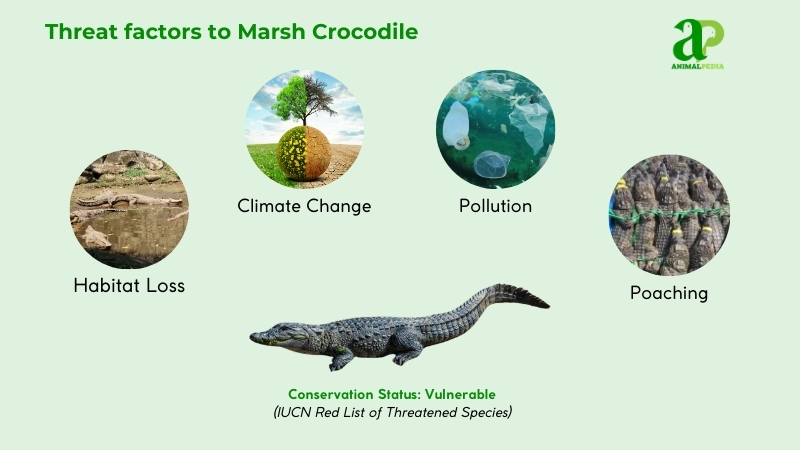
Predators rarely threaten adults. Hatchlings fall to birds like herons, monitor lizards, and jackals—brief risks before maturity. Adults reign as apex hunters.
Human impact dwarfs all else. Urban sprawl and fishing nets trap crocodiles, while the leather trade fuels kills. Whitaker and Whitaker (2015) document a 20% decline in India’s population since 2000, attributed to wetland loss and human conflict. Conservation lags behind need.
Are Marsh crocodiles endangered?
Marsh crocodiles are endangered. The IUCN Red List classifies them as Vulnerable, one step below Endangered status. This 2017 assessment reflects significant threats from habitat destruction and human encroachment across their range.
These mugger crocodiles (Crocodylus palustris) face population pressure throughout India, Pakistan, Sri Lanka, and Nepal. Their numbers have declined approximately 20% since 2000, despite their adaptability to various freshwater ecosystems.
Current population estimates indicate 10,000-15,000 mature individuals in the wild. Whitaker and Whitaker’s research (2015) documented relatively stable subpopulations in Gujarat and Wilpattu National Park, totaling 5,000-7,000 specimens. Kumara and Raj (2016) identified approximately 1,200 individuals in Gujarat’s Charotar wetland complex.
Conservation initiatives, particularly India’s crocodile breeding and reintroduction programs, have prevented further decline. However, these reptiles are threatened by agricultural expansion, water diversion projects, and human-wildlife conflict throughout their historical range.
What conservation efforts are underway?
Marsh crocodiles benefit from focused conservation programs. The IUCN-SSC Crocodile Specialist Group (CSG) has led initiatives since the 1970s. India launched its Crocodile Conservation Project in 1975, supported by UNDP and FAO, which successfully restored populations.
Strong legislation protects these reptiles. India’s Wildlife Protection Act of 1972 (Schedule I) prohibits hunting and trading marsh crocodiles, with jail terms for violators. Sri Lanka’s Fauna & Flora Protection Ordinance bans killing, though enforcement is inconsistent. Iran imposes fines of 100 million rials under the 2013 laws. CITES Appendix I listing prevents international trade.
Captive breeding has proven effective. The Madras Crocodile Bank Trust, established in 1976, produces hundreds of hatchlings yearly. Over 1,000 crocodiles have been released into sanctuaries like Satkosia Gorge by 2018. By 2016, Gujarat’s Charotar wetlands had received 200 reintroduced crocodiles, and their populations are now thriving. Related conservation efforts raised saltwater crocodile numbers from 96 in 1976 to 1,640 by 2012.
The CSG’s sustainable use model connects conservation with local livelihoods, reducing human-wildlife conflict and increasing population numbers. This integrated approach, combining law enforcement, scientific breeding, and community involvement, keeps the mugger classified as Vulnerable rather than Endangered.
Frequently Asked Questions
What makes Marsh Crocodiles such skilled hunters?
Marsh crocodiles are stealthy predators that use their powerful jaws and camouflage to ambush prey. They often lie motionless for long periods, waiting for unsuspecting fish, birds, or mammals to venture too close to the water’s edge, where they strike with incredible speed.
How do Marsh Crocodiles stay safe in their murky habitats?
Their secret weapon is their ability to blend into their surroundings. With a dark, rough texture on their skin and an ability to stay submerged for long periods, marsh crocodiles can be almost invisible to both prey and potential threats in their muddy and shallow habitats.
Can a Marsh Crocodile’s bite crush anything?
Yes! With one of the strongest bites in the animal kingdom, a marsh crocodile can crush the bones of its prey. Their jaws are equipped to clamp down with immense force, allowing them to catch and hold onto fish, birds, and even large mammals.
Do Marsh Crocodiles play any role in their ecosystems?
Absolutely! As apex predators, marsh crocodiles help regulate the populations of smaller animals, maintaining a balance in their ecosystems. They also help control fish and bird populations, preventing overgrazing of aquatic plants and other vital resources in their habitat.
How do Marsh Crocodiles care for their young?
Unlike many reptiles, marsh crocodiles exhibit some parental care. After laying their eggs, the mother will guard the nest fiercely until the hatchlings emerge. When they do, the mother often helps the babies reach the water, increasing their chances of survival in their early days.
Conclusion
Marsh crocodiles, or mugger crocodiles (Crocodylus palustris), are apex predators with their 3-5 meter length, broad snouts, and powerful jaws. These reptilian predators inhabit the freshwater ecosystems of South Asia, from Pakistan to Nepal and India. Their ecological significance cannot be overstated—they control prey populations, remove sick animals, and maintain aquatic health through complex trophic cascades.
The keystone species demonstrates exceptional adaptability across varied habitats, including rivers, lakes, and artificial reservoirs. Despite facing habitat destruction and poaching threats, conservation efforts have helped stabilize some populations. Their behavioral repertoire includes sophisticated hunting strategies, maternal care, and complex social hierarchies.
Understanding these ancient saurians deepens our appreciation for biodiversity conservation. Their continued survival represents nature’s resilience against anthropogenic pressures. The marsh crocodile stands as a living testament to evolutionary success spanning millions of years.





